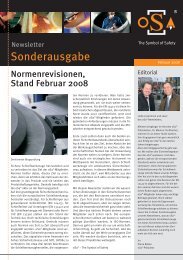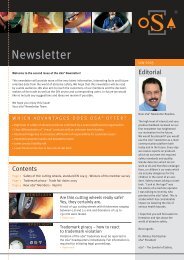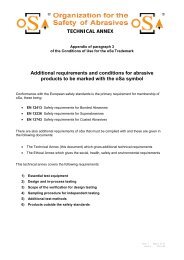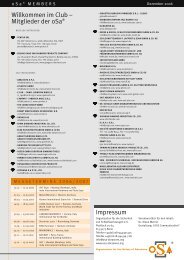7. oSa Newsletter - Organisation für die Sicherheit von ...
7. oSa Newsletter - Organisation für die Sicherheit von ...
7. oSa Newsletter - Organisation für die Sicherheit von ...
Create successful ePaper yourself
Turn your PDF publications into a flip-book with our unique Google optimized e-Paper software.
S E R I E S T E S T I N G B Y T H E M A N U F A C T U R E R<br />
February 2010<br />
Part 4: Impact resistance<br />
Our series aims to provide an<br />
overview of the different test<br />
methods for abrasives. The<br />
requirements of the safety<br />
standards are high, based on<br />
a decade-long experience<br />
accumulated by independent<br />
test institutes. It is the overall<br />
aim to ascertain that even in<br />
case of foreseeable misuse an<br />
abrasive will have resistance<br />
to failure. The protection of<br />
the end-user is the first<br />
priority for all <strong>oSa</strong>-members.<br />
So far we presented the burst<br />
speed test, the destructive<br />
segment test for diamond<br />
cutting-off wheels and dish<br />
wheels as well as the side load<br />
test. In the last newsletter<br />
we explained the single and<br />
three-point side load test.<br />
These tests provide information<br />
on the resistance of abrasives<br />
to side load and jamming.<br />
These two test methods are<br />
supplemented by the impact<br />
resistance that measures the<br />
resistance of the wheel to<br />
sudden lateral shock. This test<br />
is mandatory for all resinoid<br />
bonded depressed centre<br />
wheels (ISO-type 27, 28 and<br />
29) as well as for depressed<br />
and straight cutting-off wheels<br />
(type 41 and 42), 150 mm<br />
diameter and above, for use<br />
on hand-held machines.<br />
The test principle is easy. The<br />
test sample is mounted to a<br />
spindle by means of flanges<br />
and then taken up to its<br />
maximum operating speed.<br />
The rotating abrasive is<br />
laterally subjected to one<br />
or several impacts supplied<br />
successively by means of a<br />
pendulum until failure. Details<br />
on the implementation of<br />
the tests can be taken from<br />
the EN 12413.<br />
Picture 1 shows the pendulum<br />
Picture 1: Pendulum<br />
applied at the IFA (formerly<br />
BGIA). The impact energy can<br />
be adjusted by changing the<br />
drop height or by loading<br />
additional mass.<br />
Picture 2: Breakage into several pieces<br />
One typical damage pattern<br />
is shown in picture 2. Besides<br />
regular function checks, the<br />
calibration of the test stand in<br />
certain intervals is important.<br />
For example, dirt that got into<br />
the bearing can increase the<br />
bearing friction and thus minimize<br />
the drop energy that<br />
impacts the abrasive. The IFA<br />
recommends to have the pendulum<br />
calibrated by an external<br />
institute at least once a year.<br />
M E M B E R<br />
P O R T R A I T<br />
Manufacturers of bonded abrasives<br />
Bonded abrasives are one of<br />
the most common and well<br />
known of the abrasive groups.<br />
Since grinding is one of the<br />
oldest manufacturing<br />
processes, you will be bound<br />
Mounted points<br />
to have come across this<br />
product group at some time.<br />
These products are also of<br />
major importance to <strong>oSa</strong>. One<br />
factor that all these bonded<br />
abrasives have in common is<br />
that they utilise conventional<br />
abrasives such as aluminium<br />
oxide and silicon carbide,<br />
not diamond or cubic boron<br />
nitride. There are also the<br />
newer zirconia-alumina and<br />
sol gel abrasives. Originally,<br />
there were numerous natural<br />
hard materials used such as<br />
sandstone, garnet, emery and<br />
corundum but these were<br />
found to be too inconsistent<br />
for modern requirements.<br />
The abrasive grains are held<br />
together by a bond. The type<br />
and nature of the bond determines<br />
the grinding characteristics<br />
obtained. There are<br />
several bond types available.<br />
Among the inorganic bond<br />
types, the ceramic or vitrified<br />
bond plays the decisive role<br />
within <strong>oSa</strong>. The use of silicate<br />
and magnesite bonds has<br />
diminished considerably in<br />
recent times.<br />
The most common of the<br />
organic bonds is resinoid<br />
bond, normally a phenolic<br />
(Bakelite). Less popular are<br />
rubber, shellac, epoxy or<br />
thermo-plastic bond types.<br />
With a market share of an<br />
estimated 2.2 bn. USD (as of<br />
2004), bonded abrasives<br />
constitute the second biggest<br />
product group after coated<br />
abrasives. Although the handheld<br />
and mobile machines<br />
present the greatest safety<br />
risks, stringent safety requirements<br />
also apply to stationary<br />
machines. For example, an<br />
abrasive wheel for highpressure<br />
steel conditioning<br />
can easily weigh several ten<br />
kilos and operates at speeds<br />
up to 80 m/s. Its bursting<br />
would have serious consequences,<br />
not only for the<br />
worker, (since not all machines<br />
are totally-enclosed), but<br />
also the machine could be<br />
badly damaged.<br />
Grinding process<br />
There are currently 25 manufacturers<br />
of bonded abrasives<br />
who are members of <strong>oSa</strong>.<br />
Many of them have played a<br />
decisive role as founding<br />
members in formulating the<br />
<strong>oSa</strong>-safety philosophy.<br />
Substantial aspects of this<br />
philosophy also found entry<br />
into the European Safety<br />
Standard, EN 12413. This<br />
standard was revised in 2007<br />
and now offers a solid basis<br />
for the self-certification of the<br />
<strong>oSa</strong>-members. The <strong>oSa</strong>-trademark<br />
on an abrasive wheel<br />
provides the end-user with a<br />
sense of security as it indicates<br />
a product with a high and<br />
verifiable level of safety.<br />
Vitrified bonded wheel









